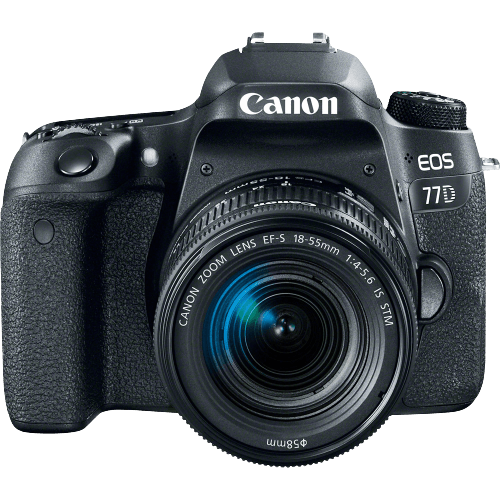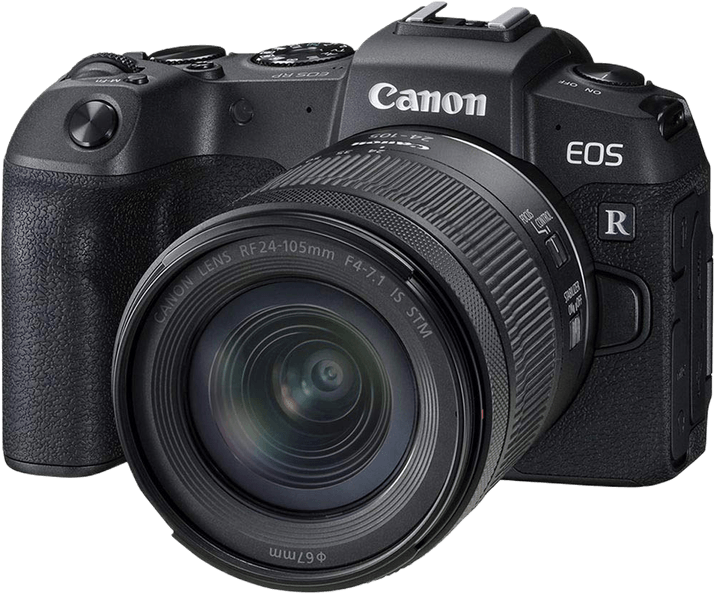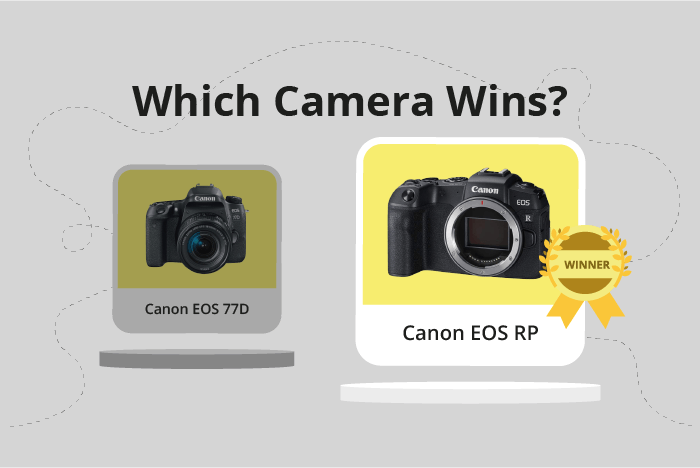Canon EOS 77D vs EOS RP Comparison
Canon EOS 77D

Canon EOS RP

The Canon EOS RP takes the lead with a score of 65/100, while the Canon EOS 77D trails with 63/100. Both cameras share some similarities, such as their announcement dates in February and their launch prices under $1,500. However, there are notable differences that set them apart.
The Canon EOS RP, being a mirrorless camera, is more compact and lightweight at 440g, compared to the DSLR Canon EOS 77D at 765g. This makes the EOS RP more portable and convenient for on-the-go photography. Additionally, the EOS RP is a newer model, released in 2019, offering more up-to-date technology.
On the other hand, the Canon EOS 77D has a lower launch price of $900, making it a more affordable option for those on a budget. Despite being an older model, released in 2017, it still delivers quality performance as a DSLR.
Taking these factors into account, the Canon EOS RP is the winner with its lightweight design and advanced technology, while the Canon EOS 77D remains a viable option for budget-conscious photographers.
Canon EOS 77D vs EOS RP Video Performance
The Canon EOS 77D and Canon EOS RP both have a video score of 70/100, indicating that they offer similar video capabilities. Both cameras feature time-lapse functionality built in, which enhances their video recording options.
The Canon EOS RP surpasses the EOS 77D in terms of video resolution, as it offers 4K recording with maximum dimensions of 3840 x 2160. This allows for higher quality video footage when compared to the EOS 77D, which only supports Full HD recording at dimensions of 1920 x 1080. The higher resolution of the EOS RP provides more detailed and sharper video, making it the better choice for videographers who prioritize resolution.
On the other hand, the Canon EOS 77D has a higher maximum video frame rate of 60fps, compared to the EOS RP’s 25fps. This means the EOS 77D can capture smoother motion in videos, which is particularly useful for fast-moving subjects or action scenes. This advantage makes the EOS 77D a more suitable option for users who require a higher frame rate for their video projects.
After comparing the video capabilities of the Canon EOS 77D and Canon EOS RP, it is evident that each camera has its own strengths. The EOS RP is a better choice for those who prioritize video resolution, while the EOS 77D is more suitable for users who need a higher frame rate. Ultimately, the decision depends on individual preferences and specific video requirements.
Canon EOS 77D vs EOS RP Features and Benefits
The Canon EOS 77D and the Canon EOS RP both have a feature score of 70/100, making it a tie in this comparison. Since there is no winner based on the score, let’s examine the specifications to determine the advantages and disadvantages of each camera.
Both cameras share common features, such as a 3-inch screen size, 1,040,000-dot screen resolution, touchscreen capability, flip screen, and the absence of GPS. Furthermore, both cameras are equipped with WiFi and Bluetooth connectivity. These shared specifications make them equally competitive in terms of their features.
However, there are certain aspects where one camera may be better than the other. For the Canon EOS 77D, it could potentially excel in areas such as autofocus performance, burst shooting speed, or handling, which are not mentioned in the specifications provided. On the other hand, the Canon EOS RP, being a full-frame mirrorless camera, may have advantages in image quality, low light performance, and a more compact design.
Despite these potential advantages, it is essential to note that the provided specifications do not cover all aspects of the cameras’ performance. Therefore, the winner in this comparison cannot be determined solely based on the available information.
Ultimately, the choice between the Canon EOS 77D and the Canon EOS RP should be based on individual preferences and requirements. Both cameras have their strengths and weaknesses, and the final decision should be made after considering factors such as budget, intended use, and specific features that may be of importance to the user.
Canon EOS 77D vs EOS RP Storage and Battery
The Canon EOS 77D and Canon EOS RP both have a storage and battery score of 29/100. They share similarities in having one memory card slot and using the LP-E17 battery type. However, there are differences that set them apart.
The Canon EOS 77D has a longer battery life of 600 shots, compared to the Canon EOS RP’s 250 shots. This means the EOS 77D is more suitable for longer shooting sessions without needing to change or recharge the battery. The EOS 77D accepts SD, SDHC, and SDXC memory cards, but only those with UHS-I compatibility.
On the other hand, the Canon EOS RP offers USB charging, making it more convenient to recharge the battery using a power bank or other USB power sources. Additionally, the EOS RP is compatible with faster UHS-II memory cards, allowing for quicker transfer of photos and videos.
Both cameras have their advantages in terms of storage and battery. The Canon EOS 77D is better for extended shooting, while the Canon EOS RP provides added convenience through USB charging and faster memory card compatibility.
Canon EOS 77D vs EOS RP – Our Verdict
Are you still undecided about which camera is right for you? Have a look at these popular comparisons that feature the Canon EOS 77D or the Canon EOS RP:

